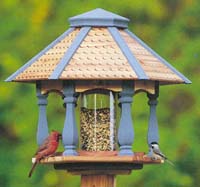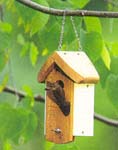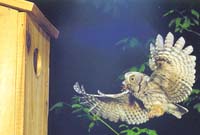Selecting a Bird House
In the birdhouse business, there’s no such thing as “one size fits all.” Material Wood is just about the best building material for any birdhouse. It’s durable, has good insulating qualities and breathes. Three-quarter-inch-thick bald cypress and red cedar are recommended. Pine and exterior grade plywood will do, but they are not as durable It makes no difference whether the wood is a slab, rough-cut or finished, as long as the inside has not been treated with stains or preservatives. Fumes from the chemicals could harm the birds. There’s no need to paint cypress and cedar, but pine and plywood houses will last longer with a coat of water-based exterior latex paint. White is the color for purple martin houses. Tan, gray or dull green works best for the other cavity-nesting species. The dull, light colors reflect heat and are less conspicuous to predators. Don’t paint the inside of the box or the entrance hole.
Regardless of which wood you select, gluing all the joints before you nail them will extend the life of your birdhouse. Galvanized or brass shank nails, hinges, and screws resist rusting and hold boxes together more tightly as they age. Resist the temptation to put a metal roof on your birdhouse. Reflective metal makes sense for Martin houses up on a sixteen-foot pole, but when it’s tacked onto the roof of a wood chickadee house, the shiny metal is more likely to attract predators. Natural gourds make very attractive birdhouses. They breathe, and because they sway in the wind they are less likely to be taken over by house sparrows and starlings. Grow your own gourds and you’ll have dozens to choose from in the years ahead. If you don’t have the space to grow them, a coat of polyurethane or exterior latex (on the outside only) will add years to the one you have. Properly designed pottery, aluminum (for purple martins only), concrete and plastic houses are durable but don’t drop them. Gourd houses are the easiest to set up. String them from a wire between two poles, from a sectional aluminum pole, or on pulleys mounted to a crossbar high up on a pole. You can mount lightweight aluminum houses for martins on telescoping poles, providing easy access for maintenance and inspection. Because of their weight (more than 30 pounds), wood houses should not be mounted on telescoping poles. You’ll have to use a sturdy metal or a wood pole attached to a pivot post. The problem with this lowering technique is that you can’t tilt the house without damaging the nests inside. If you put your house on a shorter, fixed pole, ten to twelve feet high, you can use a ladder to inspect and maintain it. Flycatchers The great crested flycatcher and its western cousin, the ash-throated flycatcher, are common in wooded suburbs and rural areas with woodlots. Their natural nesting sites are abandoned woodpecker holes. Flycatchers may nest in a birdhouse if it is placed about ten feet up in a tree in an orchard or at the edge of a field or stream. This is a longshot, but well worth the effort if you are successful. Woodpeckers You can attract all types of woodpeckers with a suet feeder, but only the flicker is likely to use a birdhouse. They prefer a box with roughened interior and a floor covered with a two-inch layer of wood chips or coarse sawdust. Flickers are especially attracted to nest boxes filled with sawdust, which they “excavate” to suit themselves. For best results, place the box high up on a tree trunk, exposed to direct sunlight. Try building a birdhouse for the other species of woodpeckers following the guidelines in this booklet. You might be surprised Owls Most owls seldom build their own nests. Great horned and long-eared owls prefer abandoned crow and hawk nests. Other owls (barred, barn, saw-whet, boreal, and screech) nest in tree cavities and birdhouses Barn owls are best known for selecting nesting sites near farms. Where trees are sparse, these birds will nest in church steeples, silos, and barns. If you live near a farm or a golf course, try fastening a nest box for owls about 15 feet up on a tree trunk Screech owls prefer abandoned woodpecker holes at the edge of a field or neglected orchard. They will readily take to boxes lined with an inch or two of wood shavings. If you clean the box out in late spring after the young owls have fledged, you may attract a second tenant-a kestrel. Trees isolated from larger tracts of woods have less chance of squirrels taking over the box.
Be sure to provide ventilation, drainage, and easy access for maintenance and monitoring. Concrete (or a mix of concrete and sawdust) offers protection other houses cannot: squirrels can’t chew their way in. |
Other Links:
- For the birds
- Back yard bird feeding
- Bird Feeder Selection
- How Many Birds
- Birds Attracted by Various Feeders and Foods
- Uninvited Guests at the Birdfeeder
- Questions about Feeding Wild Birds
- Homes for Birds
- Selecting a Bird House
- Bird House Design
- Bird Nest Box Dimensions
- Bird House Placement
- Protection from Predators
- Attracting Birds
- Landscaping for Birds
- Basics of Landscaping for Birds
- Plants for Wild Birds
- How to Get Started
- Protecting Bird Habitat
- Additional Readings

 Decide which bird you want to attract, then get a house for that particular bird. Look through any book or catalog and you’ll see birdhouses of all sizes and shapes, with perches and without, made of materials you might not have thought of. recycled paper, gourds, plastic, rubber, pottery, metal and concrete. The proper combination of quality materials and design makes a good birdhouse.
Decide which bird you want to attract, then get a house for that particular bird. Look through any book or catalog and you’ll see birdhouses of all sizes and shapes, with perches and without, made of materials you might not have thought of. recycled paper, gourds, plastic, rubber, pottery, metal and concrete. The proper combination of quality materials and design makes a good birdhouse.
